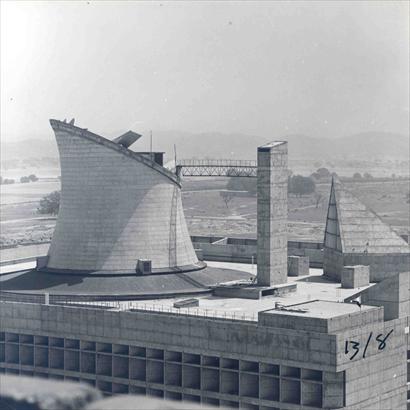The vast project in the Punjabi capital was entrusted to Le Corbusier in the early 1950s, when the latter’s fame was at its peak. In this work done with his cousin Pierre Jeanneret (who directs the site in Chandigarh), Le Corbusier puts his signature on the design and construction of the capitol palaces that include: The Assembly, the Secretariat, the Palace of Justice, the Governor’s Palace as well as the surrounding parks. Since 1951, Xenakis has been involved in the project in various ways, beginning with the Climatic Grid, inspired by the CIAM Grid for Urbanism. This theoretical study, which was shelved due to criticism from the authorities and Indian architects, would have made it possible to adapt architectural research thanks to a controlled monitoring of annual variations in climatic data (air temperature and humidity, thermal radiation of materials, speed of air currents). It would have also allowed the passive air-conditioning of low-cost houses in Chandigarh. Xenakis’ love for astronomy led him to study in detail the harsh climate of this country and its phenomena. His penchant for theoretical work gave birth to the “Theoretical Study of Sunshine”, a graphic research of visualization of climatic data for a whole year. Later, in 1955, Xenakis’ facility with the geometry of forms would help Le Corbusier define the hyperboloid of the lower chamber of the Assembly. This form, freely inspired by the cooling towers of nuclear power plants and happily put on a sheet of paper by the master, will find its precise geometric description thanks to Xenakis’ calculations and the construction of an impressive wooden model. With his friend and Greek engineer, Pavlopoulos, he works on the static profile of the tower and its interior design. Xenakis proposed that the upper part of the tower function as a “sun laboratory”, a kind of astronomical observatory, an idea that was not realized due to technical and budgetary restrictions. He also collaborated with Philips engineers (who were responsible for the Philips Pavilion project at the 1958 World’s Fair, entrusted to the Le Corbusier studio) in order to solve acoustic problems as well as ventilation and lighting problems within the tower. Finally, to solve the problem of the fenestration of the Secretariat’s facades, Xenakis and Le Corbusier used a technique used by Indian masons (spotted by Pierre Jeanneret during the construction). On a non-load-bearing facade, they decided to build up frameless glass directly on the concrete and to alternate it with pivoting wooden panels to ensure ventilation.
Being at the same time responsible for the project of the Sainte-Marie de la Tourette Convent, which presents the same problem of fenestration of the long non-load-bearing facades, Xenakis will elaborate a device of distribution of glass panels by calling upon his musical research on the rhythm. From a range (called “wave”) of standard distances – taken from the two series of the Modulor linked to the golden ratio – Xenakis generates transformed ranges that he superimposes, inverts and permutes, setting up a kind of “spatial counterpoint” on the different floors. This non-regular distribution avoids the monotony of an accumulation of identical windows. It will be the subject of a patent registered by Le Corbusier and will henceforth bear the name of “pans de verres ondulatoires”. It will become a signature for the workshop for several works, even after the departure of Xenakis in 1959.

